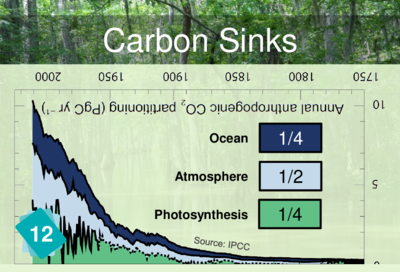En-en adult card 12 carbon sinks: Difference between revisions
Jump to navigation
Jump to search
No edit summary |
|||
| Line 6: | Line 6: | ||
== Explanation == | == Explanation == | ||
The original IPCC graph represents both CO2 emissions and carbon sinks. The Climate Collage has chosen to split it in two to show where CO2 comes from and where it goes. This is why the two cards are symmetrical: every year, the CO2 emitted by man has to go somewhere. Any CO2 that is not absorbed by the carbon sinks remains in the atmosphere. | |||
The text at the back of the card gives approximate absorption rates. The more detailed percentages are : | |||
* 27.9% for the ocean | |||
* 28.8% for photosynthesis<ref>[./Https://www.ipcc.ch/site/assets/uploads/2018/03/WG1AR5 SummaryVolume FINAL FRENCH.pdf Page 51 of IPCC's fifth technical summary report (French)]</ref>. | |||
== References == | |||
<references /> | |||
Revision as of 19:37, 3 February 2021
Card #12: Carbon Sinks
| Causes | Consequences | |

|
Half of the CO2 we emit every year is absorbed by carbon sinks :
- 1/4 by the vegetation (through photosynthesis)
- 1/4 by the ocean
The remaining half (1/2) stays in the atmosphere.
Explanation
The original IPCC graph represents both CO2 emissions and carbon sinks. The Climate Collage has chosen to split it in two to show where CO2 comes from and where it goes. This is why the two cards are symmetrical: every year, the CO2 emitted by man has to go somewhere. Any CO2 that is not absorbed by the carbon sinks remains in the atmosphere.
The text at the back of the card gives approximate absorption rates. The more detailed percentages are :
- 27.9% for the ocean
- 28.8% for photosynthesis[1].
References
- ↑ [./Https://www.ipcc.ch/site/assets/uploads/2018/03/WG1AR5+SummaryVolume+FINAL+FRENCH.pdf Page 51 of IPCC's fifth technical summary report (French)]